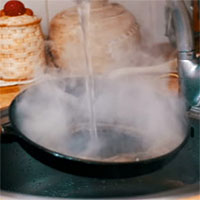This may be a silly question but why is the water wet? All previous answers about water do not explain why water is wet. We simply understand that water is naturally wet.
Likewise, we also obviously know that fire produces heat. But what makes fire hot?
According to the answer on the website of the University of California, Santa Barbara (UCSB), as a liquid, water does not wet itself, but can make other solid materials wet.
Moisture is the ability of a liquid to adhere to the surface of a solid, so when we say something is wet, it means that the liquid sticks to the surface of the material.
Whether an object is wet or dry depends on the balance between adhesive and binding forces . It can be roughly understood that binding force is two similar things that stick together, and adhesion force is two different things that stick together.

Water does not wet itself, but can cause other solid materials to become wet.
Binding is the attractive force in a liquid that causes the molecules in the liquid to “like” to stick together. The binding force is also related to the surface tension. If the binding forces are very strong, then the molecules of the liquid are extremely close and they will not spread out much across the surface of an object.
In contrast, the adhesive force is the attractive force between the liquid and the material surface. If the adhesive force is strong, the liquid will try and spread to the surface as much as possible. So how wet the surface is depends on the balance between these two forces. If the adhesive force (liquid-solid) is greater than the binding force (liquid-liquid), we say that the material is wet and the liquid tends to spread outward to maximize contact with the surface. On the other hand, if the cohesive force (liquid-solid) is less than the binding force (liquid-liquid), we say that the material is dry and that the liquid tends to granulate into a spherical drop and try to minimize contact with the surface.
Water actually has a pretty high bonding force due to hydrogen bonding, and so it wets the surface less well than some liquids like acetone or alcohol. However, water wets certain surfaces such as glass. Adding detergent to water can make water wetting better because its binding force is reduced. Water-resistant materials such as Gore-tex fabric are made from hydrophobic (water-repellent) materials and therefore the bonding force in water (liquid-liquid) is much stronger than adhesive forces (solid-liquid) and water can tendency to grain on the outside of the material and keep it dry.
That is also the reason to explain why it is also a liquid, but the degree of wetting between water, cooking oil, milk … is different. And if your children ask you why the water is wet, don’t answer them because water is a liquid. Because there are non-wetting liquids like mercury.

Fire is hot because thermal energy (heat) is released.
According to Thoght.co, fire is hot because thermal energy (heat) is released when chemical bonds are broken and formed during combustion. Combustion turns fuel and oxygen into carbon dioxide and water. For the reaction to take place, energy is needed to break the bonds in the fuel and between the oxygen atoms, but more energy is released when the atoms bind together to form carbon dioxide and water.
Fuel + Oxygen + Energy → Carbon Dioxide + Water + More Energy
Both light and heat are released as energy. Flames are tangible evidence of this energy. Flame consists mainly of hot gas. The embers glow because the matter is hot enough to emit incandescent light (like a stove burner), while the flame emits light from ionized gases (like a fluorescent bulb). Fireplace lighting is a clear indication of a combustion reaction, but thermal (heat) energy can also be invisible.
In short: Fire is hot because the stored energy in the fuel is suddenly released . The energy required to initiate a chemical reaction is much less than the energy released.

